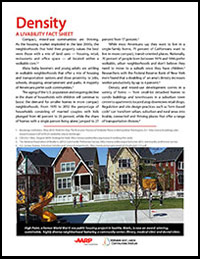AARP Hearing Center
When the housing market imploded in the late 2000s, the neighborhoods that held their property values the best were those with a mix of land uses — housing, retail, restaurants and office space — all located within a walkable core.
Today, many baby boomers and young adults are settling in walkable neighborhoods that offer a mix of housing and transportation options and close proximity to jobs, schools, shopping, entertainment and parks. A majority of Americans prefer such communities
Key Points
The fact sheet acknowledges and responds to many of the myths and preconceived notions about density and mixed use development. Here are a few.
- Myth: "Density just means big, ugly apartment buildings."
While aprartment buildings are an example of density housing, so are townhouses, accessory units and live-work spaces that accommodate a broader range of lifestyles. These residences are in addition to, not instead of, single-family detached homes with front porches and small yards. Smart density also includes areas for parks and open space.
- Myth: "Density brings traffic and parking problems.”
By combining a mix of land uses (housing, businesses, schools, etc.) density brings daily destinations within an easy walk, bicycle ride or transit trip. People spend less time driving and looking for parking. Traffic counts fall with well-designed higher density development and make transit a viable option.
- Myth: "Rural towns can't benefit from density."
Increasing a small town’s density so it can feature the benefits of a more urbanized lifestyle can be key to the community’s future success. If increasing density in the town core becomes a priority of the community’s growth plan, it can decrease some of the negative effects of the kind of population loss common in many rural regions.
How to Use
Because the fact sheets in the Livability series are only four pages each, the materials are quick and easy to read online or to download and print for sharing.
The Density fact sheet can be used by policy makers, urban planners, transportation planners, land use officials, housing specialists, community leaders and citizen activists to educate themselves and others about how to smartly plan and build mixed-use neighborhoods and developments.
Fact sheet published Summer 2014




























































